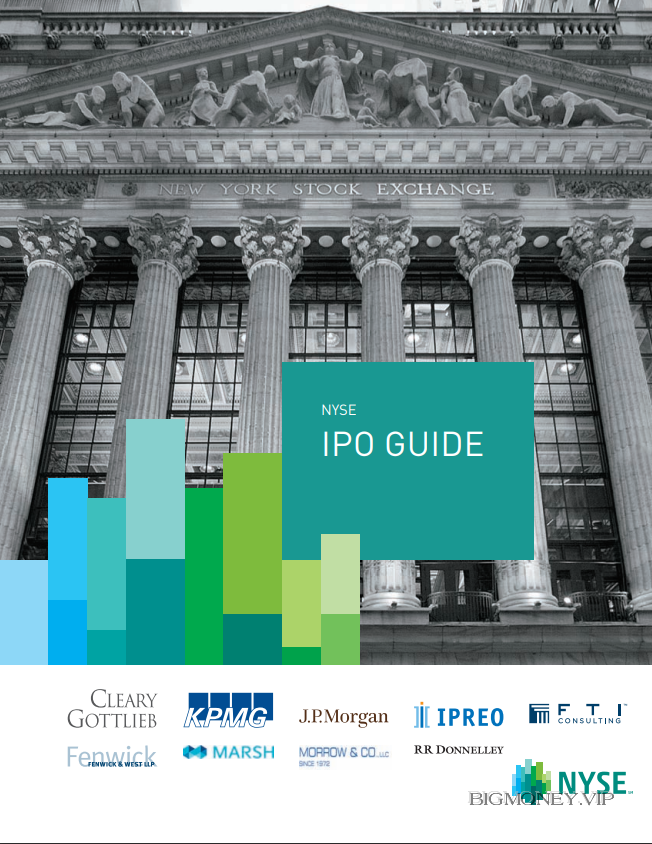NYSE IPO Guide

1
Why go public?
1.1 Advantages of conducting an IPO
J.P. Morgan (Investment Banking)
When considering an initial public offering
(IPO), a company should evaluate the
associated pros and cons, as well as
the motivations for going public. This
evaluation process is best conducted in
conjunction with an investment bank,
which can assist the company in working
through the salient issues. There are
numerous advantages to going public, the
most pertinent of which are detailed below.
(a) Access to capital
The most common reasons for going public
are to raise primary capital to provide the
company with working capital to fund
organic growth, to repay debt or to fund
acquisitions. Further direct results include
the following:
• Once the company is public, it has
access to an entirely new, deep and
liquid source of capital for any future
needs it may have.
• Being publicly traded adds equity
to the company’s capital-raising
toolkit, enabling the company to
achieve and maintain an optimal
capital structure.
• Following the IPO, the company will
be able to tap the equity markets via
follow-on offerings of primary and/
or secondary shares, or a mix thereof.
After the company has been public for
one year, it will be eligible to access the
equity capital markets on demand via a
shelf registration statement.
(b) Liquidity event
Listing on the NYSE has numerous
benefits, not only for the company but
also for its shareholders. The IPO can be
structured such that existing owners of
the company can sell down their position
and receive proceeds for their shares. In
addition, once the company is public, the
existing owners have a public marketplace
through which they can monetize their
holdings in a straightforward and orderly
fashion.
(c) Branding event and prestige
By listing on the NYSE, the company will
receive worldwide media coverage through
the financial markets, which provide
constant live coverage on publicly traded
companies. In addition, research analysts
at broker-dealers will begin to write
reports on the stock and the company, thus
raising the profile of the company. Broader
coverage across various sources will likely
enhance the company’s visibility, increase
its stature with actual and potential
customers and suppliers and thus help
it grow its market share and competitive
position.
(d) Public currency for acquisitions
Once the company is public, it can use its
publicly tradable common stock in whole
or in part to acquire other public or private
companies in conjunction with, or instead
of, raising additional capital. Publicly
tradable stock is clearly more attractive to
target shareholders than illiquid private
company stock.
(e) Enhanced benefits for current
employees
Stock-based compensation incentives
align employees’ interests with those
of the company. By allowing employees
to benefit alongside the company’s
financial success, these programs increase
productivity and loyalty to the company
and serve as a key selling mechanism
when attracting top talent. Furthermore,
issuing equity-based compensation
will allow the company to attract top
talent without incurring additional
cash expenses. Being a public company
provides employees with the ability to
monetize the value of their stock-based
compensation, whether it is options or
restricted stock.
1.2 Potential issues
J.P. Morgan (Investment Banking)
While there are numerous advantages
to going public, there are also a few
considerations that the company, its
management and shareholders should
evaluate prior to embarking on the
IPO process. The most successful
companies with the smoothest IPO
processes are those that fully weigh these
considerations before embarking on an
IPO and that begin making the necessary
preparations months, if not years,
beforehand.
(a) Loss of privacy and flexibility
In order to comply with securities laws,
public companies must disclose various
forms of potentially sensitive information
publicly, which regulatory agencies, as well
as competitors, can then access. Private
companies can operate without disclosing
proprietary information in a public forum.
In addition, the focus of research analysts
and the investor community on quarterly
results and stock price performance
may have the effect of constraining the
operational flexibility enjoyed by the
management of a private company.
(b) Regulatory requirements and
potential liability
Correspondingly, public companies must
regularly file various reports with the
Securities and Exchange Commission
(SEC) and other regulators. In order to
comply with disclosure requirements,
companies often need to completely
revamp or expand their existing
documentation policies, which can be
costly and time-consuming. In addition,
directors and officers are potentially
liable for potential misstatements and
omissions in the registration statement
and in the company’s ongoing reporting
under the Securities Exchange Act of 1934
(the Exchange Act).
(c) Sarbanes-Oxley
The Sarbanes-Oxley Act was passed
in 2002 as a reaction to a number of
major corporate and accounting
scandals, which cost investors billions
of dollars and shook public confidence
in the nation’s securities markets.
SOX set new standards for public
companies, including requirements
relating to accounting, corporate
governance, internal controls and
enhanced financial disclosure. SOX
compliance can be a time-consuming
and costly process for a newly public
company. Although the JOBS Act relieves
emerging growth companies (EGCs) of
the obligation to have their independent
auditors provide an attestation on internal
controls under Section 404(b), they are
still required to put in place internal
controls sufficient for management to
provide the certifications required by
Section 404(a)




